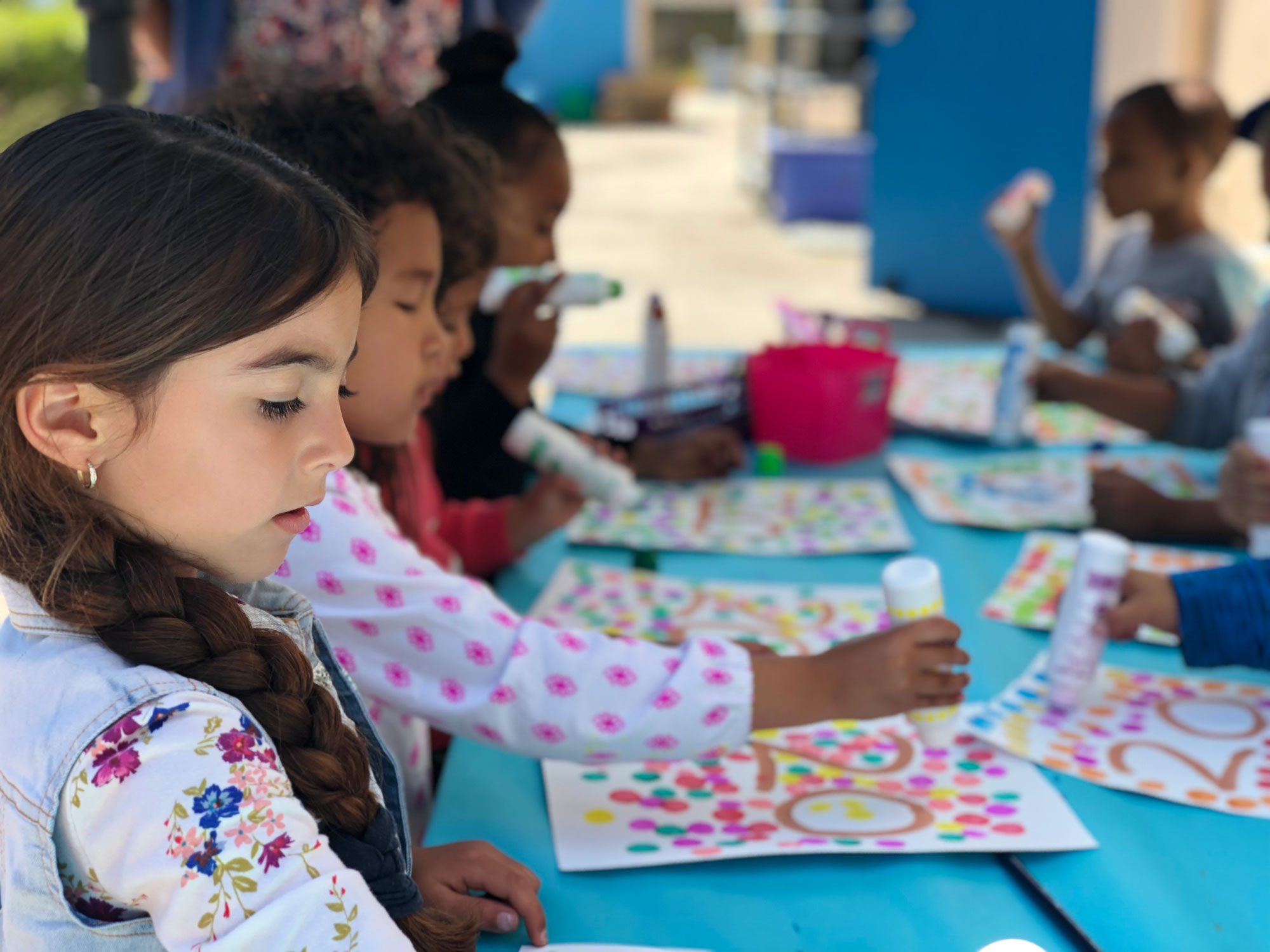
The Anita Zucker Center for Excellence in Early Childhood Studies is bridging the research-to-practice gap through a powerful initiative that is fostering inclusion in the classroom for young children with or at risk for disabilities using embedded instruction methods.
Building off both past and current research supported by the Institute of Education Sciences at the University of Florida, Embedded Instruction California (EI CA) is a collaborative project that began in 2015. The purpose of the EI CA project is to scale up and sustain a system of professional development to support preschool teachers’ use of embedded instruction practices by integrating Embedded Instruction for Early Learning — Tools for Teachers with existing statewide early childhood initiatives in California. Partners in this project include the Anita Zucker Center for Excellence in Early Childhood Studies, the Special Education Division of the California Department of Education and project sites in preschool classrooms located in Los Angeles, Santa Clara, Napa, Etiwanda, Pleasanton, Sonoma, Imperial, Mendocino/Ukiah and Chico. The EI CA project aligns with the Anita Zucker Center’s mission to bridge the research-to-practice gap by supporting practitioners to implement effective teaching practices. Embedded instruction is an effective teaching practice.
The EI CA project has three major benefits:
- It introduces preschool teachers to embedded instruction and supports their implementation of embedded instruction in the classroom.
- It helps young children with or at risk for disabilities to learn skills or behaviors that enable them to access and participate in a preschool curriculum alongside their peers with and without disabilities.
- Anita Zucker faculty and project staff learn alongside our collaborating partners about how to effectively scale up and sustain the implementation of embedded instruction practices and what additional research is needed to help address practical implementation issues we encounter.

What is Embedded Instruction?
Embedded Instruction is a method of instruction that has been shown to be effective for teaching young children with disabilities during everyday activities, routines and transitions in the preschool classroom rather than in separate settings or Activities.
Embedded instruction practices are organized under four primary components:
- What to Teach
- When to Teach
- How to Teach
- How to Evaluate

Dr. Patricia Snyder, principal investigator for the past and current research on embedded instruction at UF, describes the process:
“In a typical preschool classroom, there are many child-initiated and teacher-led activities taking place as well as routines such as arrival, snack and departure. There are also transitions between the activities and routines. All children benefit from learning in the context of these activities. Embedded instruction means rather than providing instruction for a child with a disability in a separate room or in a separate activity or routine, the teacher embeds instruction in the ongoing activities, routines and transitions in the classroom. To do this type of instruction, the teacher has to think about what skills the child is learning (what to teach), in which activities, routines or transitions it is most logical and appropriate to teach the skill (when to teach), which instructional procedures to use (how to teach) and how to monitor if teaching is implemented as planned and if the embedded instruction helps the child learn the skill (how to evaluate). While it might look effortless when done well, embedded instruction requires skillful planning and implementation to ensure children with or at risk for disabilities learn alongside their peers.”
What is the Embedded Instruction California Project?
The EI CA Project provides an opportunity to support the implementation of embedded instruction as part of a state-wide initiative. Teachers and coaches in California are initially provided with 15 to 18 hours of asynchronous online and face-to-face workshop training on embedded instruction practices. Coaches receive an additional 24 hours of training on how to support teachers to apply the embedded instruction practices in their classroom and how to use practice based coaching. Practice-based coaching is an evidence-based coaching framework grounded in the science of how people learn. During the first year of participation in the project, coaches have 12 coaching sessions for each teacher following the online and face-to-face training on embedded instruction. The coaching sessions include an observation in the classroom and individualized feedback and assistance in implementing embedded instruction. In addition to these coaching sessions, teachers participate in quarterly embedded instruction professional learning communities with other teachers at their site and receive ongoing coaching support based on their individual implementation needs for up to two years. Recognizing the important role coaches play in supporting teachers’ implementation of embedded instruction, coaches meet bi-weekly by video-conference call with members of the Anita Zucker Center EI CA Project team to refine their knowledge and skills related to both embedded instruction and the practice-based coaching framework.
Making an Impact
According to Dr. McLean, co-principal investigator on the project, the opportunity to collaborate to implement the EI CA project was an important one. “The California Department of Education and specifically the Special Education Division were interested in using the Desired Results Developmental Profile (DRDP, 2015) assessment, which measures children’s learning and developmental outcomes, to help teachers identify what skills children need to learn and then use embedded instruction to provide effective instruction for young children with disabilities. They asked members of the Anita Zucker Center to develop an approach to professional development that would help teachers connect the DRDP(2015), the CA Preschool Learning Foundations, children’s individualized education program (IEP) goals and embedded instruction, given the positive outcomes from the Anita Zucker Centers’ previous research on embedded instruction,” McLean said. She continued, “Embedded instruction is effective for teaching young children in inclusive environments. It was also seen by the state of California as an important way to encourage the inclusion of young children with disabilities in programs with their typically developing peers.”
Looking to the Future
The fourth year of the EI CA project has brought exciting new collaborative efforts among the more than 20 site-based coaches, site administrators, the CA Department of Education and members of the Anita Zucker Center. The California Department of Education, Special Education Division, is developing a cadre of state-based trainers and coaches who can effectively implement the embedded instruction and practice based coaching activities. This strategic approach to building capacity within sites throughout the state of California will help increase teachers’ access to the embedded instruction and will help sustain the use of embedded instruction and practice-based coaching as essential components of the state’s preschool professional development system.
Sheila Self of the CA Department of Education recently reflected on her experience with the embedded instruction project:
“Embedded Instruction has been one of the most effective evidenced-based practices I have been involved with to date. Not only does it improve child outcomes, but also has a meaningful impact on the knowledge and skills of teachers and coaches involved in the project. In California, the embedded instruction project has supported teachers to use DRDP(2015) child assessment data to provide targeted embedded learning opportunities that impact the child’s progress overtime. Practice-based coaching is viewed by all collaborators as highly effective. Through continued collaboration with the Anita Zucker Center, practice-based coaching can be used to support teachers to use a number of evidence-based teaching practices. In California, we plan to replicate the use of practice-based coaching to support other research to practice efforts. California’s children have benefited greatly from the collaboration from the Anita Zucker Center, the leadership team of site administrators, preschool teachers and coaches supporting these efforts.”
To date, the project has impacted more than 300 target students with disabilities who received services in inclusive preschool classrooms and 148 teachers. Anita Zucker Center researchers anticipate that these numbers will grow during the 2018-19 school year to include 86 additional teachers and more than 150 additional children.
 Early Childhood
Early Childhood
